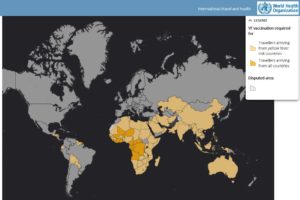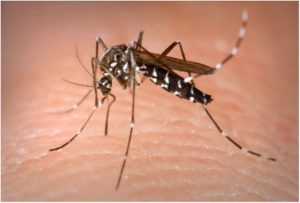Everyone generally knows why we get vaccines but how much do we really know about the diseases / viruses that we are getting them for? The roots for this series of posts goes back to all of those shots we received in basic training and I think can provide perspective and general awareness today. Then, I could not get an adequate answer for why we really needed all of these shots other than, “to keep you from getting sick.” Even when I was an 18D I never really explained the shots in terms of history, sign and symptoms and treatment. I just gave the shot and moved on. Honestly, there was not much discussion. I figured that, for general awareness, we should do a quick run down of the ‘why’ behind each of the vaccines that the U.S. Military gives just to add some depth to your next intramuscular (IM) shot.
Disclaimer
I am not going to use this space to argue the importance of vaccines. Just the facts. From the U.S. Army Medical Department:
Immunization against disease is an important part of your medical readiness for worldwide deployment. The Soldier Medical Readiness Center screens your medical record and immunization record for documentation of receiving vaccination. If there is no documentation, we must assume you were never vaccinated.
The immune response protects the body against disease. Immunization is a means of triggering the immune response and providing long-lasting protections. With vaccination, you get protection from a specific germ or virus without ever suffering through the disease. Because the immune response may diminish over time, vaccines known as “boosters” are sometimes given to restore the immune response against a particular germ/virus.
The following is the current list of the vaccinations that the typical Army recruit gets for medical readiness.
Hepatitis B Vaccine
Hepatitis A Vaccine
Influenza Vaccine
Measles, Mumps, and Rubella (MMR) Vaccine
Inactivated Polio Vaccine
Tetanus-Diphtheria-Pertussis Vaccine
Typhoid Vaccine
Yellow Fever Vaccine
Tuberculosis Screening
Meningococcal Vaccine
Where one deploys will determine what additional vaccines that you may require prior to departure. Each region has its own list but for the sake of brevity, I am going to combine all of the lists into one and not repeat the vaccines that are required in multiple areas of operations. According to Health.mil the additional required vaccines are:
Chickenpox Vaccine
Pneumococcal Vaccine
Rabies Vaccine
Anthrax Vaccine
Influenza Northern Hemisphere (NH)
Influenza Southern Hemisphere (SH)
Japanese Encephalitis
Smallpox
All of the them together, that is a big list! Again, I am not going to try to discuss the potential side effects of the list in total but I will talk about the side effects for each individual vaccine. The vaccine / disease du jour Yellow Fever.
Yellow Fever
According to the CDC:
The yellow fever virus is found in tropical and subtropical areas of Africa and South America. The virus is spread to people by the bite of an infected mosquito. Yellow fever is a very rare cause of illness in U.S. travelers. Illness ranges from a fever with aches and pains to severe liver disease with bleeding and yellowing skin (jaundice). Yellow fever infection is diagnosed based on laboratory testing, a person’s symptoms, and travel history. There is no medicine to treat or cure infection. To prevent getting sick from yellow fever, use insect repellent, wear long-sleeved shirts and long pants, and get vaccinated.

Fig. 1 Interactive world map crated by the WHO available at: https://who.maps.arcgis.com/apps/MapSeries/index.html?appid=ad0ff71cdd1b4c139cfad91daca886fb
More alarming however is this article from The Economist dated May 17, 2016 detailing where a Yellow Fever outbreak ‘could’ spread to if the right conditions are met. Additionally, the article estimates that up to 80,000 deaths occur every year in Africa due to Yellow Fever. However, the CDC estimates that Yellow Fever causes upwards 200,000 cases a year and kills approximately 30,000 with 90% occurring in Africa.

Fig. 2 A 2016 Map of Potential Yellow Fever Outbreak obtained from: https://www.economist.com/graphic-detail/2016/05/17/where-yellow-fever-could-spread-next
History
30,000 deaths! Considering the widespread availability of a vaccine that is sort of shocking, maybe not? The estimated population of the world is 7.8Billion! But what about the history of Yellow Fever? After a quick check on Wikipedia, it appears that North America has had at least 25 major outbreaks of Yellow Fever with the last major outbreak occurring in 1905 in New Orleans. The highest death toll from an outbreak occurred in the Lower Mississippi Valley in 1878 and claimed about 20,000 lives. Another significant outbreak occurred in Philadelphia in 1793 (emphasis mine):
The Yellow Fever Epidemic of 1793 struck during the summer in Philadelphia, Pennsylvania, where the highest fatalities in the United States were recorded. The disease probably was brought by refugees and mosquitoes on ships from Saint-Domingue. It rapidly spread in the port city, in the crowded blocks along the Delaware River. About 5000 people died, ten percent of the population of 50,000. The city was then the national capital, and the national government left the city, including President George Washington. Philadelphia, Baltimore and New York suffered repeated epidemics in the 18th and 19th centuries, as did other cities along the East and Gulf coasts.[11]
Let me repeat that just to let it settle in, 10 percent of the regional population. I could not find information about a global Yellow Fever outbreak or pandemic.
For a great read (or listen) on the true impact of Yellow Fever I recommend this article from New Orleans Public Radio: How Yellow Fever Turned New Orleans Into The ‘City Of The Dead’. The article describes an outbreak as such:
Yellow fever was fatal. It was gruesome. And in epidemic years, during the months between July and October, it could wipe out 10 percent of the city’s population. Eventually, it earned New Orleans the nickname “Necropolis” — city of the dead.
Yellow fever didn’t just kill. It created an entire social structure based on who had survived the virus, who was likely to survive it and who was not long for this world. And that structure had everything to do with immigration and slavery, according to Kathryn Olivarius, a history professor at Stanford University.
Signs and Symptoms
So, what are the signs and symptoms of Yellow Fever? Back to the CDC:
- Most people will not have symptoms.
- Some people will develop yellow fever illness with initial symptoms including:
- Sudden onset of fever
- Chills
- Severe headache
- Back pain
- General body aches
- Nausea
- Vomiting
- Fatigue (feeling tired)
- Weakness
- Most people with the initial symptoms improve within one week.
- For some people who recover, weakness and fatigue (feeling tired) might last several months.
- A few people will develop a more severe form of the disease.
- For 1 out of 7 people who have the initial symptoms, there will be a brief remission (a time you feel better) that may last only a few hours or for a day, followed by a more severe form of the disease.
- Severe symptoms include:
- High fever
- Yellow skin (jaundice)
- Bleeding
- Shock
- Organ failure
- Severe yellow fever disease can be deadly. If you develop any of these symptoms, see a healthcare provider immediately.
- Among those who develop severe disease, 30-60% die.
How is it Transmitted
Yellow Fever is transmitted through the bite of an infected Aedes or Haemagogus mosquitoes.

Fig 3. Aedes Mosquito image obtained from: https://www.connectedtoindia.com/spike-in-aedes-mosquito-population-in-first-three-months-of-the-year-4065.html
Diagnosis
The CDC states that yellow fever is diagnosed in the lab and is based on the persons symptoms and travel history. Specifically, they perform a serum test for yellow fever antibodies.
Treatment
This is the scary part that sounds a bit familiar. The CDC indicates that there is no medicine to treat or cure yellow fever. More:
- There is no medicine to treat or cure infection from yellow fever.
- Rest, drink fluids, and use pain relievers and medication to reduce fever and relieve aching.
- Avoid certain medications, such as aspirin or other nonsteroidal anti-inflammatory drugs, for example ibuprofen (Advil, Motrin), or naproxen (Aleve), which may increase the risk of bleeding.
- People with severe symptoms of yellow fever infection should be hospitalized for close observation and supportive care.
- If after returning from travel you have symptoms of yellow fever (usually about a week after being bitten by an infected mosquito), protect yourself from mosquito bitesfor up to 5 days after symptoms begin. This will help prevent spreading yellow fever to uninfected mosquitoes that can spread the virus to other people.
Vaccine
Yes please! The vaccine in administered subcutaneously, (the area below both layers of skin in a ‘fatty area like the back of your arm) with a 0.5ml dose. You should only require 1 lifetime dose but it must be administered at least 10 days prior to travel.
Side Effects of the Vaccine
Honestly, I don’t care, I’ll take it anyway, but according to the U.S. Army’s Medical Department the side effects to the vaccine are mild headaches and muscle pain.
Conclusion
The purpose of this post is not to draw parallels to the current COVID19 pandemic. It is for awareness only. I wanted to provide some background on some of the diseases that we are vaccinated against and also to serve as a reminder of how dangerous the world once was. Consider the fact that at one point 10% of the population of a given area was killed by this disease! Yellow Fever, while primarily limited to Africa, is a disease that has the potential to impact many lives and should be take seriously. I hope that the next time that you go in for a vaccination you remember a small portion of this article and better understand the why behind each shot you are given. Next week: Typhoid Fever.

